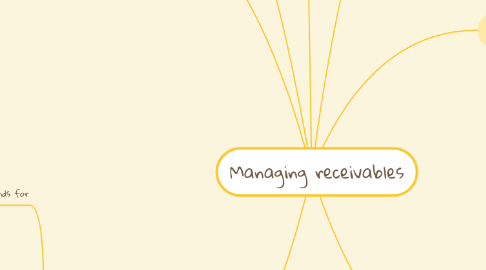
1. Assessing creditworthiness
1.1. Credit status information
1.1.1. Internal resource
1.1.1.1. Customer's payment history
1.1.1.2. Customer's financial health
1.1.2. EXternal sources
1.1.2.1. On companies
1.1.2.1.1. Bank references
1.1.2.1.2. Trade reference
1.1.2.1.3. Insolvency register
1.1.2.1.4. Credit reference agency
1.1.2.1.5. financial statements
1.1.2.2. On individuals
1.1.2.2.1. Bank references
1.1.2.2.2. Credit reference agency
1.1.2.2.3. Credit application form
2. Credit reference agency reports
2.1. Recommended credit limit
2.2. Assess creditworthiness of customer
2.3. Trading opinion
2.4. Risk rating and how this compares with other businesses in same industry
3. Financial statement analysis
3.1. Areas to investigate
3.1.1. Key ratios to check
3.1.1.1. Gross margin
3.1.1.2. Return on capital employed
3.1.1.3. Asset turnover
3.1.1.4. Gearing
3.1.2. Liquidity
3.1.3. Profitability
3.1.4. Efficiency
3.1.5. Stability
4. Legal issues
4.1. Grounds for
4.1.1. Contents of payable ledger account
4.1.2. supplier in breach of terms conditions of contract
4.2. Issues with payments
4.2.1. Must be contract-with offer and accpetance
4.2.2. Contract based on written termd and conditions
4.2.3. Consideration given by both parties
4.2.4. Sale must also comply with any relevant legislation
4.2.4.1. Legal situation
4.2.4.1.1. Unfair contract terms act 1977
4.2.4.1.2. Sale of goods act 1979
4.2.4.1.3. Data Protection act 1998
5. Giving credit
5.1. Trade credit
5.1.1. Given to customers in normal course of business operations
5.1.2. given to customer to make sales
5.2. Cost of giving credit
5.2.1. Irrecoverable debts
5.2.2. Cost of capital
5.2.2.1. Less cash available for business
5.3. Credit terms
5.3.1. Credit limit
5.3.1.1. Total amount of credit allowed
5.3.2. Payment date
5.3.2.1. Period of tiime from invoice date when payment due.
5.4. Credit and cash flows
5.4.1. Affects cash flow
5.4.2. Most important source of liquidity for a company
6. Credit policy
6.1. Confirms standard terms of business
6.2. Procedures for amending for individual customers
6.3. Identify customers with poor credit rating
6.4. States settlement discount
6.5. Sets out method of assessing credit
6.6. Sets out penalties for late payments
7. Refecting credit applications
7.1. Procedure
7.1.1. Notify customer
7.1.2. Suggest alternative payment methods
7.1.3. Suggest re-apply for credit at later date when more established credit history
